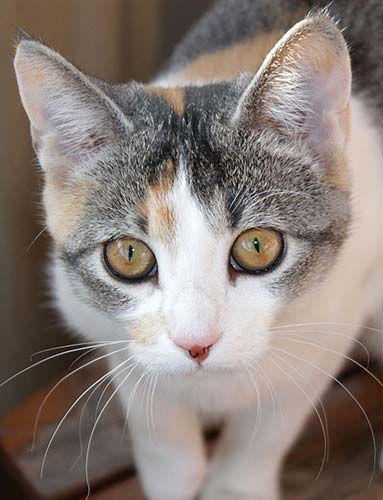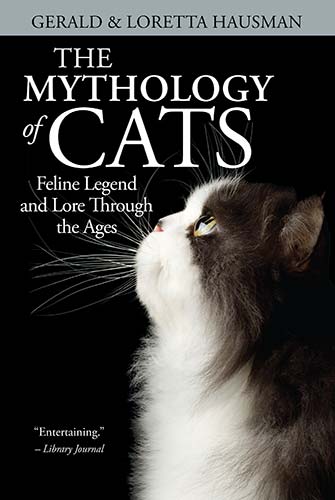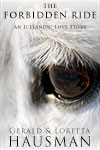

By Gerald Hausman
Bokeelia, FL, USA

Gerald Hausman
Cats have been on the human scene for 9,000 years. We came out of the caves, and they were there with us. Ever since, cats have been immortalized in art. They have been painted in fresco, sculpted in stone, carved in wood, cast in silver, and plated in gold. They have been mummified, petrified, and transmogrified into cells of film, newsprint, and popular literature. Cats have been morphed into stuffed toys and have strutted the world's stage mewing of their magnificence. And our appreciation of all things feline knows no bounds, so we've given cats innumerable names from Mau to Mew and from Pascht to Puss.
One might ask, why do cats have such grand cultural coverage? After all, we're talking about a small, mundane animal with four legs and a tail. A little pet who got aboard the Ark by being an itch in a lion's nose…well, that's another story.
It just doesn't seem possible that so much mythos could be packed into so modest a mammal. Yet such is the large truth of the small, domestic cat. Its mythology has increased its natural size to unnatural proportions. Let's find out why.
In Egypt, some 5,000 years ago, the cat was a creature of duality. Lion-headed and moon-eyed, it was already a dualistic deity, already an animal whose aspect corresponded to lunar cycles of order and disorder, harmony and imbalance. Here was a graceful animal whose eye was a miniature moon. Myths may vary about the feline of felidae, but all say—Wow! The cat! Dauntless creature of earth, water, air and fire. Elemental being that lives many lives. Psychic creature of incomparable beauty that can fall from great heights without being hurt. Soundless hunter whose eyes see all!
What better way to measure the thing called cat than to recount the manifold myths that have sprung up over the centuries that it has guided us in places where we see but darkly. Yes, the cat guardian of humankind is always there in our stories of the collective unconscious. Here are some of the ones that have stuck like a splinter in the human mind reminding us that when gods walked upon the earth, there was always—Cat.
Iroquois myths from North America tell of Old Woman Moon and her companion, Bobcat. While she weaves a head strap, symbolic of the moon's shape, Bobcat sits patiently beside her. Then, when she gets up to stir a pot of hominy on the fire, Bobcat pounces on Old Woman Moon's head strap, and unravels it. So, storytellers say, the cat undoes the moon, forcing it change from full to famished, once every month. The moon cycle and the human female are closely related in this myth.

Figurine of the Goddess Bastet as a Cat
(Egypt, Late Period, 712-332 B.C.)
(Courtesy Los Angeles County Museum of Art)
In Incan cosmology of South America, there is an inner earth called the moon house. Inside lives a great puma or cougar. Early Andean people viewed this creature as a sun lord who nibbled at the moon, causing it to go from full to crescent. It is interesting to note that the word puma is said to come from Incan culture, or as we might say today, Quechuan. The word cougar comes from an English corruption of the Guarani -- guacuara. Some Amerindian tribes believe that the great cat sits at the top of the heavens. Is this the same Leo that we see on a winter night?
In songs, the Osage people speak of how the puma joins earth and sky and make them one.
I am the male puma who lies
Upon the earth.
I am the person who had made a
Male puma of his body.
The knowledge of my courage
Has spread over the land.
The god of day sits in the heavens.
I sit close to the god of day.
When men make me their god,
All deaths die
As they travel the paths of life.
The American Indian revered the cat of the woods, calling it "soft-footed brother." As with all animals in the natural world, Native Americans saw a purpose that grafted the lion to the man. The huntsman and the tracker saw in the secretive cat a mirror reflection, and in its golden hide there was the intimation of immortality. It was thought among some tribes that the flesh of the panther would ensure everlasting life. At the least, it was believed that because of the creature's sun symbolism, it was a near relation, if not a direct symbol, of the Sun Father. The animal's sense of pride, of knowing its place and not deviating from it, placed it at the top of the animal pantheon, but also at a level with people.
In Europe, too, cats were dominant in the lore of an earth-centered, tribal society. Long before the Spanish Inquisition in the 14th century, cat cults thrived in France, Germany and the British Isles. One thousand years after the death of Cleopatra, women of the Rhine met in secret groves under the high moon. There they prayed to cats for fertility, love, and good luck. They worshiped Freya, from whom we get the English word Friday. A team of whiskered cats drew her sky chariot. Freya spread the gospel of love and fertility around Italy and France. When twilight finally settled on the gods of old, Freya attended the funeral of Baldur, the cat god of youth. In her great cat wagon, she carried Baldur into Valhalla.
In Scotland cats have always been sacred. Fergus, the first king of Scotland, had Egyptian blood. The legend states that his family carried cats to the Scottish Highlands—yes, Egyptian cats! Fergus' cat-bearing ancestor, Scota, conferred her name to that country. In addition, Scotland's motto and crest contain a cat. Not surprising when you consider that cat, in Scotland, was both animal and warrior. Men, in fact, went into tribal battles wearing cat masks. Battling cats graced the crests of old Clan Cattan. Even the skirling wails of the bagpipe, legend says, came from the fighting fury of wrathful felines.
When the Romans first came to the Netherlands, they found a tribe living at the mouth of the Rhine that called themselves Cat People. Their town Cat Vicense is still there. Its name, restored to the language of the Cat People, is now, or was in the 1950s, Katwyk or Cattown.
The myths of Ireland are also rich in cat lore. The Celts attempted to banish snakes with incantations. But when that didn't work, they employed the paws and claws of cats. Saint Patrick, who is the unofficial patron saint of wolfhounds, had no use for snakes. He also did not like felines, perhaps because he thought their magic was of a similar kind. So Saint Pat banned both serpent and cat from the emerald isle.

In various parts of the world, from Great Britain to the Pacific Rim, it was believed that cats controlled weather. In fact 19th century maritime insurance companies wouldn't insure a cargo without a cat-in-residence. In England, when coastal weather went bad, sailors placed a tortoiseshell cat in an iron pot and put the lid on until the thunder stopped. The ship's cat that saves the day is a very old legend indeed and there are many words that reflect this in a variety of languages.
There is, for example, the catboat, or simply, the cat. The catamaran that rights itself in a turbulent sea is well founded on the feline faculty of cats landing on their feet. In Italian, the term gatta marina refers to the boat that comes upright in rough surf. There is also the tackle, or pulleys, used to suspend the anchor to the—here we go again—cat's head of a ship.
Cats of the sea, octopi, are clever creatures. Although they may have eight legs instead of nine lives, this marine animal is cat-quick and sinuous. Its large, all-seeing eyes have a catlike cornea that gives them a range of vision of 180 degrees. In Haitian voodoo, the sea mother, Erzulie, has a cat guardian for a best friend. The cat and the sea and the luck therein are found in African mythology.
The name tortoiseshell obviously invokes the turtle and the cat, symbols of longevity, balance and harmony, not to mention maternal love. Is there anything more devoted than a mother cat? Or more representative of mother earth than a turtle? Native Americans were not wrong in naming North America, Turtle Island.
Is there mythic similarity between the cat and the snake? Ancient Egyptians believed that the day was ruled by Ra and the night by Apep. Ra, who was catlike, wrestled in Apep's coils until he defeated him at sunrise. Interestingly, folklorists tell us that Patrick's banned cats swam back to Egypt where they were loved and worshiped all over again. Water seeks its own level, and so apparently do mythological cats.
Patrick wasn't the only one to ban cats in Europe. During the Inquisition, cats were anything but popular. They were burned along with their familiars, witches. The poor animal and the hapless Wiccan went the way of fire. What did cat lovers do during the next three hundred years? Mostly they hugged a metaphysical feline, who was a creature of their imagination. Perhaps never before and never since has an animal that didn't exist been called into action because people wanted it to exist. You can compare this with Bigfoot, but it isn't quite the same thing.
The make-believe feline whose name was Kabouterje, Colfy, and Goblin was a changeling, both cat and human. In some myths, Goblin was a clever little man, who could also change into a cat. Arguably, he wasn't a cat at all, but an ugly-looking little person who lived in barns, at the bottom of wells, in gardens and mountain caves—something like a little troll cat.
Goblin still lives in European world literature and has many names. The Dutch called him Kabouterje. The French, Gobelin. The Germans, Kobald. The Russians, Colfy. The Welsh, Coblyn. The English, Goblin. In time, the fires of the Inquisition cooled. By then, the cat came back, as the old folksong says. It was time for Goblin, the stand-in, to leave. Who should usher him out? None other than his feline counterpart, Cat.

In the Scandinavian countries, the cat of choice that guarded the house and chased away goblins was the Buttercat, known as smierragatto. He watched over bread, butter, milk and cheese. Its favorite place to sleep was by the stove. In Finland, the buttercat lived in the rafters and brought good luck to all who showed respect. In return this utilitarian cat did household chores.
Keep in mind, this was a real flesh and blood feline, but it was imbued with the magical trappings of myth. When erecting a new house, the Finnish builder always made sure to bring along a shovel of ashes—a gift for the buttercat. As everyone knows, cats like to leave their remains in ashes.
While the concept of the good kitchen cat grew and spread throughout Europe, Goblin, once a good-natured guy, turned short-tempered. There were thus many tales of the good buttercat versus the bad goblin.
In France the buttercat was known as matagot. This was the magical cat of the Midi that brought good luck to all who fed him. On the peninsula of Brittany in the northwest of France, this providential feline wasn't called buttercat but rather moneycat. Nine-lived, this cat served nine owners at one time.
The significance of good luck and the number nine is not incidental. The earliest mention refers to Muhammad and his cat Muezzin. One day while Muezzin slept on Muhammad's sleeve, the prophet rose to leave, and rather than wake Muezza, he cut off his sleeve. After this he stroked Muezza three times down the length of his back. This myth explains why cats always land on their feet when they fall—the result of Muhammad's original blessing. Mythologists also say that the story implies that three times three is nine—thus, nine lives. Muhammad's severed sleeve became the gift of longevity to all cats.
The long-lived, sacred cat is yet another universal myth. The Japanese temple cat, sometimes called the kimono cat, has a dark spot—this is the obi, or tie of the kimono. Long ago such cats were brought to monasteries and deposited there for sake-keeping. The kindly tradition continues in Japan, regardless of cat colors or features.
In terms of breed, the prototypical kimono cat was the Japanese bobtail. When the cat's colors were black, red and white, the cat was good luck -- mi-ke, meaning three color. In Japanese painting, sculpture and luck charms, the mi-ke cat (a tortoiseshell) sits straight with paw upraised in a generous gesture of goodwill.
In mythology and in life, all things come to a close. But perhaps not to a finish. So as we close here, we might take a last look at that most restful image—the sleeping cat. Like the earth, the feline's graceful lines flow from the tip of its nose to the tip of its tail. In sumi, Japanese wet brush paintings, the curled cat is a single line representing the circular sea, the round moon, the entire universe, in repose.
Links:
Gerald Hausman at Stay Thirsty Publishing
Gerald Hausman - Author & Storyteller







